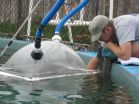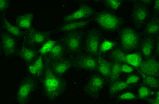(Press-News.org) The oncologists Manuel Hidalgo, Director of the Clinical Research Programme of the Spanish National Cancer Research Centre (CNIO), and Ignacio Garrido-Laguna, member of the Experimental Therapeutics Program at Huntsman Cancer Institute of the University of Utah (USA), have recently published a review of state-of-the-art clinical treatments for pancreatic cancer -- including the most current therapies and innovative research -- in the prestigious scientific journal Nature Reviews Clinical Oncology.
In their study, which reviews around 200 scientific articles published over the past 30 years, the authors issue a reminder that, despite the fact that over the last decade advances have been made in our understanding of the biology of this type of tumour, no therapeutic targets have been discovered to date that can be successfully translated into better therapies. This is one of the reasons why pancreatic cancer continues to be one of the most deadly cancers. However, researchers are now approaching the subject from a different angle, namely the potential application of immunotherapy together with other treatments that may significantly increase patient survival rates; this could also lead to a reconsideration of the nature of this illness and help to guide future therapeutic strategies.
A POSSIBLE SYSTEMIC ORIGIN FOR PANCREATIC CANCER
Hidalgo and Garrido-Laguna raise two questions to bear in mind: on the one hand, there are still no current effective screening methods for detecting pancreatic cancer in its initial phases. On the other hand, despite the advances made in surgical techniques, the 5-year survival rate of patients undergoing surgery continues to be as low as ever, at around 15-20%.
The fact that the initial stages are asymptomatic makes early diagnosis and, therefore, a better chance of survival, difficult. But there could be something else: "Recent research suggests that this is a systemic illness, even during its early stages, in other words, it could involve other organs and not just the pancreas," explains Manuel Hidalgo. "If this hypothesis is confirmed, the 5-year survival rate could well be improved with the design of systemic adjuvant treatments that go beyond and complement other solutions such as surgery. Another fundamental implication of this hypothesis is that the diagnostic techniques would have to be implemented at an extremely early stage as the illness could be spreading to other organs even during its initial phases."
IMMUNOTHERAPY AND ADJUVANT TREATMENTS
A number of research projects overturn past beliefs. "This was the case, for example, with the application of chemoradiotherapy [a treatment that combines radiotherapy with chemotherapy], a strategy whose benefits have been questioned for treating non-metastatic tumours", says Hidalgo. "Nevertheless, a study is being carried out investigating the possibility that patients that have non-mutated SMAD4 gene would be the most receptive to this type of treatment; this will help oncologists when it comes to making decisions."
On the other hand, if in the past pancreatic cancer was considered as being resistant to immunotherapy, recent research carried out on patients with metastasis has provided positive results in this direction. One example of this is the GVAX vaccine, which contains tumour cells that stimulate the patient's immune system.
Further evidence could provide new therapeutic approaches: some studies point, for example, to the decisive role played by the supporting tissues of the pancreas (the stroma) in the development of this type of tumour. Furthermore, it is believed that neoadjuvant treatments could improve the effects of chemotherapy and radiotherapy and would enable treatment of metastatic pancreatic cancer at an early stage.
Specifically speaking, a statistically significant improvement of the survival rate of patients suffering from metastatic cancer has been achieved with the administration of FOLFIRINOX as well as with the combination treatment of nab-paclitaxel plus gemcitabine. The CNIO's Gastrointestinal Cancer Clinical Research Unit, led by Manuel Hidalgo, has contributed to the development of the combination therapy in several scientific studies. "We believe that one of the reasons why this drug combination works is because it selectively eliminates elements that are part of tumour stroma, but this is a laboratory hypothesis that we have to study in more detail," says the oncologist.
A RARE BUT VERY AGGRESSIVE CANCER
Pancreatic cancer is rare (it represents 2.1% of all tumours), but its incidence has increased since the middle of the 20th century. Furthermore, over 80% of patients experience a recurrence following surgery (60% of them within 6 months).
In Spain, almost 4,000 new cases are recorded every year -- 53% in men and 44% in women -- most of whom are diagnosed between the ages of 65 and 75. Each year this illness kills around 2,400 men and 2,000 women in our country.
INFORMATION:
Reference article:
Pancreatic cancer: from state-of-the-art treatments to promising novel therapies. Ignacio Garrido-Laguna, Manuel Hidalgo. Nature Reviews Clinical Oncology (2015). doi: 10.1038/nrclinonc.2015.53
PROVIDENCE, R.I. [Brown University] -- Using a technique that introduces tiny wrinkles into sheets of graphene, researchers from Brown University have developed new textured surfaces for culturing cells in the lab that better mimic the complex surroundings in which cells grow in the body.
"We know that cells are shaped by their surroundings," said Ian Y. Wong, assistant professor of engineering and one of the study's authors. "We've shown that you can make textured environments for cell culture fairly easily using graphene."
Traditionally, cell culture in the lab has ...
An enzyme secreted by the body's fat tissue controls energy levels in the brain, according to new research at Washington University School of Medicine in St. Louis. The findings, in mice, underscore a role for the body's fat tissue in controlling the brain's response to food scarcity, and suggest there is an optimal amount of body fat for maximizing health and longevity.
The study appears April 23 in the journal Cell Metabolism.
"We showed that fat tissue controls brain function in a really interesting way," said senior author Shin-ichiro Imai, MD, PhD, professor of ...
Dolphins that raise their voices to be heard in noisy environments expend extra energy in doing so, according to new research that for the first time measures the biological costs to marine mammals of trying to communicate over the sounds of ship traffic or other sources.
While dolphins expend only slightly more energy on louder whistles or other vocalizations, the metabolic cost may add up over time when the animals must compensate for chronic background noise, according to the research by scientists at NOAA Fisheries' Northwest Fisheries Science Center and the University ...
TORONTO, ON. (23 April, 2015) - A new study led by University of Toronto researcher Dr. David Lam has discovered the trigger behind the most severe forms of cancer pain. Released in top journal Pain this month, the study points to TMPRSS2 as the culprit: a gene that is also responsible for some of the most aggressive forms of androgen-fuelled cancers.
Head of Oral and Maxillofacial Surgery at the Faculty of Dentistry, Lam's research initially focused on cancers of the head and neck, which affect more than 550,000 people worldwide each year. Studies have shown that these ...
ROCHESTER, Minn. -- A 47-year-old African-American woman has heavy menstrual bleeding and iron-deficiency anemia. She reports the frequent need to urinate during the night and throughout the day. A colonoscopy is negative and an ultrasonography shows a modestly enlarged uterus with three uterine fibroids, noncancerous growths of the uterus. She is not planning to become pregnant. What are her options?
Elizabeth (Ebbie) Stewart, M.D., chair of Reproductive Endocrinology at Mayo Clinic, says the woman has several options, but determining her best option is guided by her ...
ANN ARBOR--Use of clean fuels and updated pollution control measures in the school buses 25 million children ride every day could result in 14 million fewer absences from school a year, based on a study by the University of Michigan and the University of Washington.
In research believed to be the first to measure the individual impact on children of the federal mandate to reduce diesel emissions, researchers found improved health and less absenteeism, especially among asthmatic children.
A change to ultra low sulfur diesel fuel reduced a marker for inflammation in ...
Boosting teenagers' ability to cope with online risks, rather than trying to stop them from using the Internet, may be a more practical and effective strategy for keeping them safe, according to a team of researchers.
In a study, more resilient teens were less likely to suffer negative effects even if they were frequently online, said Haiyan Jia, post-doctoral scholar in information sciences and technology.
"Internet exposure does not necessarily lead to negative effects, which means it's okay to go online, but the key seems to be learning how to cope with the stress ...
CAMBRIDGE, Mass--Drizzling honey on toast can produce mesmerizing, meandering patterns, as the syrupy fluid ripples and coils in a sticky, golden thread. Dribbling paint on canvas can produce similarly serpentine loops and waves.
The patterns created by such viscous fluids can be reproduced experimentally in a setup known as a "fluid mechanical sewing machine," in which an overhead nozzle deposits a thick fluid onto a moving conveyor belt. Researchers have carried out such experiments in an effort to identify the physical factors that influence the patterns that form. ...
April 23, 2015 - Interventional treatments--especially surgery--provide good functional outcomes and a high cure rate for patients with lower-grade arteriovenous malformations (AVMs) of the brain, reports the May issue of Neurosurgery, official journal of the Congress of Neurological Surgeons. The journal is published by Wolters Kluwer.
The findings contrast with a recent trial reporting better outcomes without surgery or other interventions for AVMs. "On the basis of these data, in appropriately selected patients, we recommend treatment for low-grade brain AVMs," concludes ...
A new study by the University of Chicago Booth School of Business Assistant Professor Amanda Sharkey and University of Utah Assistant Professor Patricia Bromley found that environmental ratings have spillover effects on other companies' behavior. Rated firms reduce their toxic emissions even more when their peers are also rated. In addition, rated peers can even motivate some unrated companies to reduce their emissions.
The research is unusual in that the role of peers in conditioning how firms respond to ratings systems has received little examination.
The study, "Can ...


